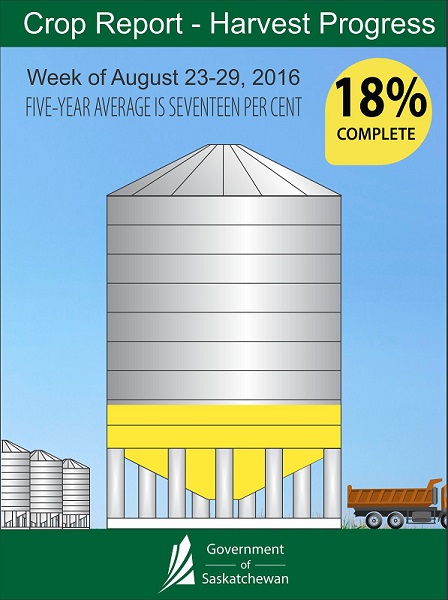Released on September 1, 2016
A break in the weather over the past few days has allowed farmers to make good harvest progress. Eighteen per cent of the 2016 crop has been combined and 32 per cent is swathed or ready to straight-cut, according to Saskatchewan Agriculture’s Weekly Crop Report. This is ahead of the five year (2011-2015) average of 17 per cent combined for this time of year.
Regionally, harvest is furthest advanced in the southeast, where producers have 34 per cent of the crop in the bin. Twenty-five per cent of the crop is combined in the southwest, 12 per cent in the east-central region, eight per cent in the west-central and northeastern regions and five per cent in the northwest.
Ninety-two per cent of winter wheat, 64 per cent of field peas, 40 per cent of lentils, 10 per cent of durum and spring wheat and seven per cent of canola have been combined. Fifty-two per cent of canola has been swathed.
Rain was reported earlier in the week, with the northern and central regions receiving the majority. The Nipawin area received the most rain—57 mm. Provincially, cropland topsoil moisture is rated as 16 per cent surplus, 79 per cent adequate and five per cent short. Crop districts around Kindersley and Tisdale are reporting surplus moisture on 43 and 46 per cent, respectively, of crop land. Hay land and pasture topsoil moisture is rated as five per cent surplus, 81 per cent adequate, 11 per cent short and three per cent very short.
Pasture conditions across the province are reported as 17 per cent excellent, 60 per cent good, 20 per cent fair and three per cent poor. As a result of a wet and humid haying season, it is estimated that four per cent of forage acres will be left unharvested, with the majority of those acres being in the west-central and northeastern regions. The majority of crop damage last week was due to prolonged flooding and disease. There are reports of higher incidences of sclerotinia in canola, fusarium in wheat and durum, and bleaching of cereals and pulses, in comparison to other years.
Producers are busy with harvest.
Follow the 2016 Crop Report on Twitter at @SKAgriculture.
-30-
For more information, contact:
Daphne Cruise
Agriculture
Moose Jaw
Phone: 306-694-3587
Email: daphne.cruise@gov.sk.ca

